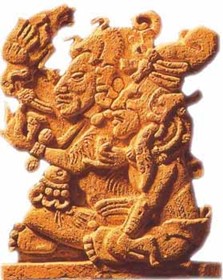 Though the practice of seppuku is virtually synonmous with ritual suicide, it’s worth noting that feudal Japan hardly had a monopoly on ceremonial self-slaughter. The Mayans were also enthusiasts, though the details of their process obviously differed from those of their peers across the Pacific. As this fascinating paper makes clear, the Mayan method involved the severing of one’s carotid artery with an axe or knife, then dancing until Death came knocking.
Though the practice of seppuku is virtually synonmous with ritual suicide, it’s worth noting that feudal Japan hardly had a monopoly on ceremonial self-slaughter. The Mayans were also enthusiasts, though the details of their process obviously differed from those of their peers across the Pacific. As this fascinating paper makes clear, the Mayan method involved the severing of one’s carotid artery with an axe or knife, then dancing until Death came knocking.
At least that was the ritual in its purest form. Yet not all participants perished—or, for that matter, were willing. The victims, the paper’s authors argue, fell into one of three distinct categories:
Firstly there are those who completely severed their carotis thus committing an act of suicide on their own free will. The ch’akba dancers on the vase from the Museo Popol Vuh and on the Robicsek and Hales vase belong to this group.
Secondly there are those who offered blood from their carotis but did not die because precautionary measures were taken, i.e. the carotis was only slightly opened and ek’ balam [a medicinal shrub—ed.] was applied. K’an Hok’ Kitam II of Palenque and the dancer on the Kerr vessel belong to this group.
Thirdly there are those who were forced to offer blood from their carotis but were denied the necessary aid. So they died in an act of imposed suicide. Waxakiahun u Bah K’awil of Copan and Pat Buts’ K’awil of Seibal belong to this group.
When the ritual was performed for genuinely religious reasons, it was done to mimic the Phoenix-like death and resurrection of the deities Hunahpu and Xbalanque. (True, the human participant never quite got to the “resurrection” part of the equation—details, details.) But we get the feeling that some cruel Mayan nobles simply used the ceremony as an excuse to dispatch with rivals, captives, and disobedient household servants. Judging by the paper’s language, we can even see how victims were conned into slicing: “Sure, go ahead and cut—I’ll be right here with the ek’balam when you’re done. Trust me.”


thingsbreak // Jul 16, 2009 at 4:19 pm
Interesting. I was at the Dumbarton Oaks museum not that long ago. I wonder if the panel mentioned in the paper was/is on display…
Brendan I. Koerner // Jul 16, 2009 at 4:25 pm
@thingsbreak: Yeah, pretty safe bet–or at the very least, they’ve got it in the back for serious researchers.
I’m a big fan of Aztec art myself. Great collection in the Yale Art Gallery basement, including a pristine depiction of a king receiving a liquor enema. The Aztecs were really into the hedonism thing.
thingsbreak // Jul 18, 2009 at 1:52 am
IIRC, that was a fairly widespread practice in precolumbian Americas and not necessarily for pleasure or relegated to the rulers per se. I think (and I am a bit too tired tonight to look into this) it’s been convincingly conjectured that such non-oral applications of alcohol were given throughout the precolumbian world to visitors, often in concert with a whirlwind tour of dazzingly white-plastered grounds (e.g. the Maya at Tikal, various Wari spaces in Peru) in order to promote disorientation and awe.
thingsbreak // Jul 18, 2009 at 1:52 am
Er, “dazzlingly”.
Brendan I. Koerner // Jul 18, 2009 at 1:16 pm
@thingsbreak: I can see how that could be disorienting. And, if done incorrectly, quite deadly:
http://www.seattlepi.com/national/210573_sherry03ww.html